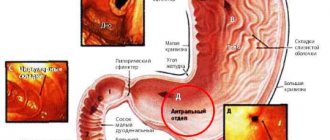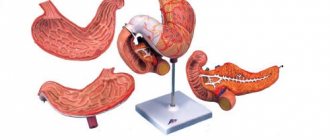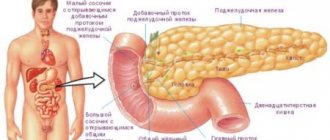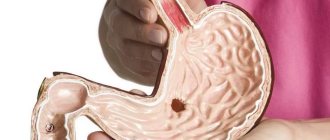Causes of food stagnation in the stomach
Not every person knows what gastric atony is. Many people first encounter this concept only in the doctor’s office. This type of disease does not occur very often.
But there are many reasons for its occurrence, such as:
- congenital organ anomaly;
- general exhaustion of the body;
- endocrine diseases;
- being in constant stressful situations;
- dysfunction of the nervous system due to intoxication with toxic components;
- thrombosis of gastric vessels;
- damage to nerve endings during surgery;
- regular overeating, which led to stretching of the walls of the organ.
The causes of the pathology are often hidden in sudden weight loss due to stressful situations, depression or anorexia. If the provoking factor is not eliminated in a timely manner, the symptoms of atony will progress further, becoming more severe.
Possible symptoms
The clinical picture of this disease is varied and depends on the area in which the obstruction causing stagnation is located.
The most alarming manifestation is vomiting. It is caused by damage to the cells of the stomach, due to which they cease to perform their functions. And also because, due to an obstruction, food does not enter the intestines and is thrown back. When the upper part of the stomach is affected, food is retained in the esophagus. Vomiting during stagnation has an unpleasant, rotten odor. It contains undigested pieces of food due to indigestion. There may be mucus or blood present.
It is also worth thinking about a possible problem if you feel a feeling of satiety that occurs even with a small amount of food consumed. It may be accompanied by:
- rotten burps;
- sudden weight loss;
- feeling of heaviness in the stomach.
At the initial stage of the disease, signs of stagnation are weak. The more the disease progresses, the worse the patient begins to feel. Symptoms may also worsen after eating solid, hard-to-digest foods.
Possible pain indicates that stagnation is accompanied by an ulcer or cancer.
Symptomatic picture
The first degree of damage is also called hypotension. At the initial stage, the patient experiences minor discomfort, which does not affect the general condition of the body. But in the absence of therapeutic measures, health worsens. Symptoms of gastric atony appear:
- in heartburn;
- in increasing the volume of the gastric cavity;
- in rapid saturation;
- in nausea and vomiting;
- in a bursting feeling;
- belching with air or sour contents;
- blanching of the skin;
- in increased blood pressure;
- in an unpleasant odor from the oral cavity;
- in increased sweating.
Stagnation of food in the stomach can occur when obstruction occurs. In this case, instant saturation occurs. Against the background of this process, appetite disappears completely. A feeling of nausea occurs, especially at the moment when a person has eaten fatty foods or drank a lot of drinks. Painful sensations are often dull and bursting in nature. When the gastric cavity is greatly stretched, cold sweat appears. The skin turns pale and acquires a grayish tint.
In more severe cases, increased heart rate and increased blood pressure are observed. Blood flow deteriorates significantly, which can lead to stomach rupture. Stagnation of food in the stomach leads to gastritis. In this case, the acidity of gastric juice may remain normal or increase slightly.
Symptoms of the disease
As mentioned above, the symptoms of gastric atony are few. The patient may be bothered by such disorders and disturbances in the body as:
- Bloating;
- Heaviness in the stomach even after a small meal;
- Acute abdominal pain that occurs periodically;
- Nausea;
- Heartburn and belching;
- Bad breath;
- Vomiting with a large amount of liquid and an admixture of greens;
- Very quick satiation even with a small amount of food;
- Cold sweat;
- Tachycardia;
- Arterial hypotension;
- Noise in the stomach (“gurgling”) upon palpation – the so-called drumming sound;
- Pathological expansion of the borders of the stomach;
- Poor circulation in the stomach;
- Dizziness;
- Hearing loss;
- Meniere's syndrome;
- Pathological loss of body weight;
- Increased stomach acidity.
Treatment of gastric atony
But this determines how drug therapy will be carried out. Treatment of food stagnation in the stomach involves the implementation of complex measures, including:
- taking medications;
- following a strict diet;
- conducting therapeutic training;
- psychotherapy;
- physiotherapeutic methods.
Before starting treatment, the gastric contents are evacuated using a tube. This helps prevent organ rupture.
Gastric atony is treated by using:
- drugs to improve motor functioning;
- anabolic steroids based on hydrolyzed protein compounds. They are needed for the asthenic structure of the organ;
- medicines to accelerate regenerative processes in the mucous membrane;
- preparations with calcium and potassium for minor hypotension;
- antiemetics. They are needed for repeated vomiting. Their effect is aimed at blocking receptors in the brain;
- immunomodulators, vitamin and mineral complexes.
In more severe cases, insulin may be required. Surgical intervention for food stagnation in the gastric cavity is not carried out, since the disease has the ability to recur.
Causes of the disease
The most common cause of hypotension or atony of the stomach and intestines is a violation of the innervation of the digestive tract. Most often, the nervous system of the gastrointestinal tract is damaged by diffuse peritonitis, myocardial infarction or complicated forms of pneumonia. In addition, the causes of pathology can be :
- blood clots in the vessels of the digestive tract;
- narrowing of the lumen of the pyloric part of the stomach;
- injury to the gastrointestinal tract and spinal cord (including during surgical interventions);
- severe infectious diseases - botulism, typhoid fever, tick-borne borreliosis, etc.;
- congenital or acquired gastroptosis - a disease characterized by pathological elongation and prolapse of the stomach;
- overeating, bulimia and other eating disorders;
- endocrine disruptions.
The disease is very common in people who are too thin or emaciated. Therefore, nutritional dystrophy and anorexia are also among the factors contributing to its development.
Principles of rational nutrition
Treatment of gastric atony involves following a strict diet. Doctors with this pathology recommend eating often, but little by little. The serving size should not exceed 200 g.
Stagnation in the stomach is eliminated with the help of those products that trigger motor function.
The list of permitted dishes includes:
- fresh or stewed carrots;
- bran bread;
- fermented milk products in the form of kefir or yogurt;
- beets;
- oranges, tangerines, grapefruit;
- buckwheat and oatmeal;
- juices based on vegetables and fruits;
- lean varieties of meat and fish.
To eliminate stagnation in the intestinal tract, the following food is excluded from the menu in the form of:
- whole milk;
- fried, fatty and smoked foods;
- cakes and pastries;
- chocolate and coffee;
- canned food;
- spices and herbs.
In addition to all this, you can eat fruits, mushrooms, garlic, radishes, and legumes in minimal quantities. They exhibit an astringent effect.
The diet should be divided into 5-6 meals. The break between meals is 1.5-2 hours. Do not forget about maintaining a drinking regime. A person should drink up to 2 liters of non-carbonated clean water per day.
Treatment of gastric obstruction
Since the disease develops gradually, it is quite easy to track, and emergency care is usually not required for patients. Emergency measures are limited to helping to induce vomiting to empty the stomach. After this, the patient should be referred for examination and inpatient treatment.
It includes taking special medications, creating a diet and nutrition regimen, and recommendations for physical activity. The patient is prescribed painkillers, antiemetics and antibiotics (undigested food is a haven for germs).
The main role is given to diet. If the cause of stagnation in the stomach is a violation of nutritional rules, it is enough to adhere to the following rules:
- eat small meals every 2-3 hours;
- eat small portions of food, avoid overeating;
- give up spicy, fatty, smoked foods;
- eat more protein foods, fruits and vegetables.
Food can be supplemented with vitamin complexes and dietary supplements recommended by a doctor.
With an advanced disease, drug treatment and diet may not be enough. In this case, the gaps are resolved on the operating table.
Therapeutic exercises for the stomach
Often the cause of gastric atony is a weakening of the muscle structures in the anterior abdominal wall. To restore their tone, it is necessary to regularly perform gymnastics.
There are several exercises that help with this.
- Exercise bike. Performed in a supine position.
- Pressing bent legs with hands.
- Throwing your legs behind your head. In this case, the lumbar region should be supported with your hands.
- Tilts to the side, back and forward.
- Raising hands to simulate splitting wood.
- Kneeling position with emphasis on hands. The legs are stretched back one at a time.
- Physical exercise is beneficial when done consistently. As an additional method, breathing exercises can be performed.
In some situations, doctors advise patients to wear a bandage. It holds the abdominal wall and prevents the muscle structures from relaxing. This device is also necessary for those people who have a sagging stomach. The bandage should only be worn while lying down. Constant wearing helps to quickly improve the condition and eliminate the discomfort associated with stretching of the organ.
Strengthening the nervous system
Symptoms of atonia often appear after stressful experiences and depression. To prevent the development of an unpleasant process, you need to avoid unpleasant situations. Emotions should only be positive. You need to learn to achieve a calm state.
Relaxation techniques will have benefits on the body. In more severe cases, patients resort to hypnosis and autogenic training. Breathing exercises that involve holding air help a lot.
If the reason lies in a serious nervous disorder, then psychotherapy sessions will be needed. In such cases, the patient is treated individually.
Traditional treatment methods
Folk remedies are used as an auxiliary method. This method of treatment is considered safe if you strictly adhere to the proportions and dosage. But you shouldn’t expect a positive result right away. The effect will occur only after 1–2 weeks.
To restore the functioning of the gastrointestinal tract, various herbs are used in the form of:
- dandelion roots;
- yarrow;
- chamomile;
- rosehip;
- plantain;
- coltsfoot;
- oregano;
- ginseng.
Herbs can be combined with each other. To prepare a medicinal infusion, you will need a spoonful of herbs and a mug of boiled water. The decoction is infused for 15-30 minutes and taken 2-3 times a day.
Cabbage juice helps restore the functioning of the gastric organ. It is prepared from fresh leaves. First they are crushed, and then the juice is squeezed out using gauze. It is recommended to drink on an empty stomach in the morning and evening hours.
Preventive actions
You can prevent the development of the disease or relapse if you adhere to preventive measures.
- Normalize nutrition. It is strictly forbidden to eat fast food, processed foods, sandwiches, as well as drink carbonated drinks and coffee.
- Follow all doctor's orders.
- Eliminate a sedentary lifestyle. If a person has a sedentary job, it is recommended to take breaks as often as possible and perform simple exercises.
- Exercise regularly in the morning and evening. There are special techniques that increase tone and strengthen the abdominal muscles.
- Give up bad habits such as smoking and drinking alcohol.
- Treat inflammatory diseases in a timely manner.
- Take care of the healthy state of the nervous system. If possible, avoid stressful situations and depression.
- Walk outdoors more often. Walking is very beneficial for the whole body.
- Maintain drinking regime. It is recommended to drink one cup of water before meals. You can wash down your food with homemade compotes and fruit drinks, green and weakly brewed black tea, and decoctions.
Various factors can lead to a pathological process. Preventing their adverse effects is sometimes difficult. But you need to take care of your health as much as possible. When the first signs appear, you should seek help from a doctor as soon as possible. Only a doctor knows what can cause the disease and what treatment to carry out.
Possible complications
If the release of bile into the stomach and esophagus is regular, a disease such as gastroesophageal reflux disease develops. Its main cause is physical and chemical damage to the mucosa due to the aggressive effects of pancreatic juice and bile acids. Pathological changes lead to the appearance of the following signs:
- regurgitation, gag reflex;
- morning cough, often accompanied by bronchospasm;
- chest pain;
- belching, hiccups;
- bitterness in the mouth;
- feeling of a “lump” behind the sternum;
- snoring at night.
Bile reflux can especially often occur in a child after birth. In infants, the disease causes clear symptoms:
- repeated “fountain” vomiting;
- sometimes with bile or blood;
- weight loss;
- increased salivation;
- recurrent cough.
When a lot of bile in the stomach stagnates for a long time, erosions can form on the damaged mucosa and a peptic ulcer can develop. An additional provocateur of the disease can be infection with Helicobacter pylori against the background of reduced immunity.
If the reflux of bile into the stomach occurs regularly, the most common consequence is biliary reflux gastritis, which manifests itself:
- pain in the abdomen;
- feeling of heaviness in the liver area;
- stool disorder (alternating constipation and diarrhea).
With late diagnosis and lack of adequate treatment, bile acids and enzymes lead to specific changes in the gastrointestinal mucosa. As a result, cell malignancy is possible, which threatens the development of adenocarcinoma (one of the most malignant tumors).
Stomach atony is one of the most dangerous diseases. The symptoms of this pathology are constantly growing, increasing, the infection affects the body and, in some cases, is incompatible with life. The disease constantly recurs in the absence of qualified medical care and proper care for the patient.
One of the complications during the disease is additional focal inflammation of the gastrointestinal tract, biliary tract and pancreas. There may be problems with normal blood supply to internal organs. If the body does not transport enough nutrients through the blood, the walls of organs may burst or rupture.
The consequences of gastric obstruction directly depend on the cause that provoked the pathology and the location of the tumor. If stagnation of food has formed in the pyloric part of the organ, then the patient experiences constant vomiting. This form of obstruction is quite rare. If the pathology has affected the distal end of the large intestine, then food can accumulate for a week or more.
If the patient has congenital gastric obstruction, the most common complication is aspiration pneumonia. Frequent attacks of vomiting disrupt water and electrolyte metabolism. There is a possibility that vomit will enter the respiratory tract or lead to gastric perforation.
When diagnosing the problem, the main difficulty is that atony is often accompanied by a number of other disorders (nervous dyspepsia or gastroptosis), and it is necessary to clearly separate the symptoms and manifestations of diseases from each other. Stomach atony is dangerous because the symptoms quickly increase, and complications do not keep you waiting.
Constant stagnation of food leads to the occurrence of inflammatory processes in any organs of the digestive system and biliary tract. The most common complication is gastritis. If the patient is not helped in a timely manner, the stomach may rupture due to a disruption in the blood supply to the walls.
Сексапильные лучшие путаны Архангельск, восхитительные и горячие, они такие игривые и стройные, что у тебя будет сегодня классный секс. Прелестницы ждут тебя. Встретят наедине, лучшие путаны Архангельск, гарантия, никаких подружек на кухне. Умение поддержать разговор, кстати, проституткам нужно и для успешного предоставления услуги «эскорт», которая доступна и вам.











